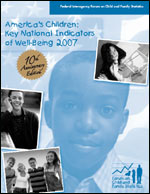CDC Features
America抯 Children: Key National Indicators of Well-Being, 2007

The annual report, America's Children: Key National Indicators of Well-Being, 2007 is a compendium of 38 key indicators—drawn from the most reliable official statistics—on important aspects of children's lives. The report is produced by the Federal Interagency Forum on Child and Family Statistics which is a collaboration of 22 government agencies, including the Centers for Disease Control and Prevention.
For detailed information see ChildStats.gov or
use the links below to help you learn more about specific areas of America’s
children.
• Family and Social Environment is about the composition of children's families and the social environment in which they live.
• Economic Circumstances presents information on the economic resources of children's households and on their food-related well-being.
• Health Care comprises the prevention, treatment, and management of illness and the preservation of mental and physical well-being through services offered by health professionals.
• Physical Environment and Safety presents indicators on how environmental conditions such as outdoor and indoor air quality, drinking water quality, and exposure to lead may affect children.
From America's Children:
Key National Indicators of Well-Being
In 2005, 60 percent of children ages 3�were read to daily by a family member. This is higher than the rate in 1993 (53 percent ) but it fluctuated in intervening years.
The proportion of all children living with a single father increased from 2 percent in 1980 to 5 percent in 2006.
The proportion of children who are overweight has steadily increased, from 6 percent of children ages 6� during 1976�80 to 18 percent during 2003�04.
In 2005, 81 percent of children ages 19� months had received the recommended combined five-vaccine series.
• Behavior focuses on illegal and high-risk behaviors such as substance use behaviors, sexual activity, and perpetration of serious violent crime.
• Education presents key indicators of how well children are learning and progressing from early childhood through postsecondary school.
• Health presents indicators of several important determinants of child health such low birthweight and infant mortality, emotional or behavioral difficulties, overweight, and asthma.
The annual report provides helpful information for families, health professionals, and scientists to better serve the needs of children and their families.
Order
a copy of America's Children: Key National Indicators of Well-Being, 2007.
Page last updated: October 29, 2007
Content source: National Center for Health Statistics
Content owner: National Center for Health Marketing
URL for this page: www.cdc.gov/Features/ChildWellBeing



